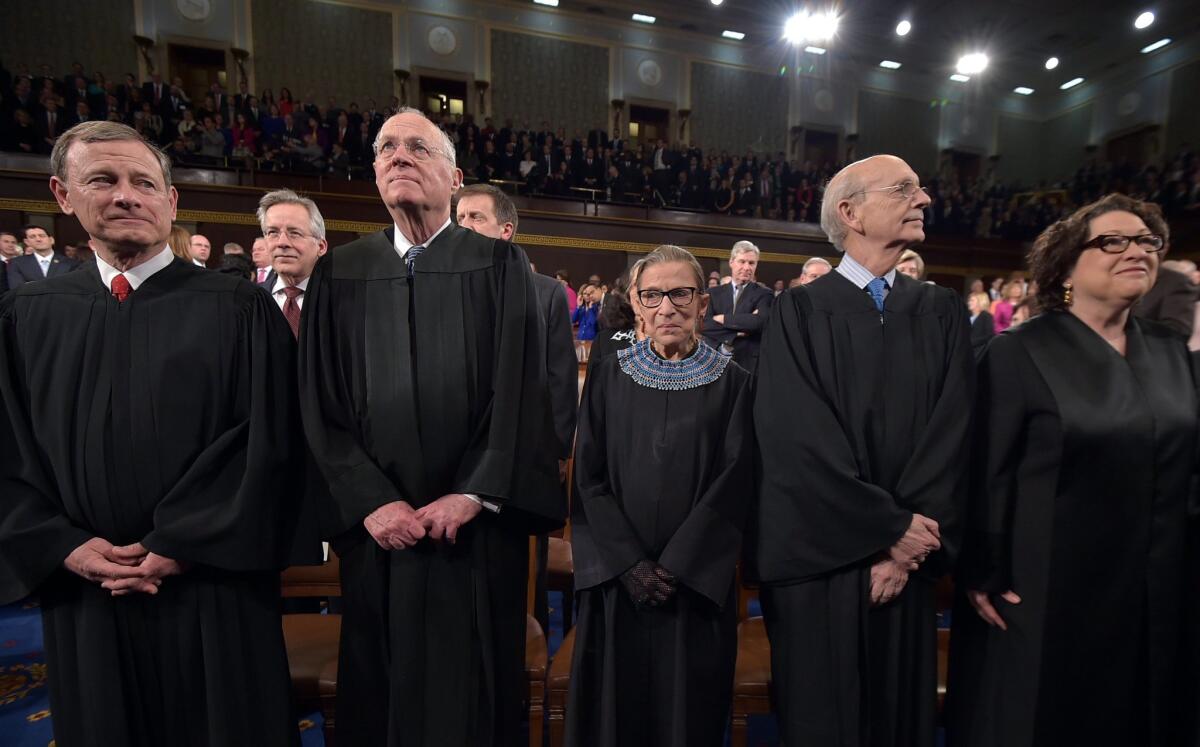Op-Ed: Justices will get no satisfaction with a new ‘one person, one vote’ rule

From left, Chief Justice John G. Roberts and Supreme Court justices Anthony M. Kennedy, Ruth Bader Ginsburg, Stephen G. Breyer and Sonia Sotomayor stand before President Barack Obama’s State Of The Union address on Jan. 20 in Washington.
- Share via
At the Supreme Court on Tuesday, the justices struggled over the meaning of the 1960s-era “one person, one vote” rule. Should Texas legislative districts contain an equal number of people — as they do now — or an equal number of eligible voters, as the plaintiffs in Evenwel vs. Abbott demand? Ultimately, the justices may have no choice but to heed some other words written in the 1960s: You can’t always get what you want.
Before the 1960s and the “reapportionment revolution,” there were few federal constitutional constraints on how district lines were drawn. In practice, this meant that many states gave much greater voting power to rural areas (with much smaller populations) than urban areas. In California, for example, as J. Douglas Smith explained in his book “On Democracy’s Doorstep,” despite huge increases in the state’s urban population, control of the Senate “remained in the hands of a shrinking rural and small-town minority.”
In Baker vs. Carr, the Supreme Court opened the courthouse doors to so-called malapportionment claims. And in a series of related cases, most famously Reynolds vs. Sims, it held that grossly malapportioned districts violated the guarantees of the Constitution, in particular the 14th Amendment’s Equal Protection Clause. Chief Justice Earl Warren later called Baker “the most vital decision” during his time on the court.
Ultimately, the justices may have no choice but to heed some other words written in the 1960s: You can’t always get what you want.
But the court never fully explained exactly what needed to be equalized — voters, people or something else. It has approved numerous district plans drawn using total population as the relevant denominator. On the other hand, the court strongly suggested in Burns vs. Richardson that a state has discretion to use something other than total population, at least when the standard is not too divergent from total population.
The issue is back before the court in Evenwel, after the court passed up numerous opportunities throughout the years to clarify the standard. In states with large noncitizen populations, especially states like Texas and California with many Latino immigrants, a ruling in favor of the challengers would shift political power from urban, Democratic areas to rural Republican ones. Cities have lots of people but not necessarily lots of eligible voters.
At the oral argument Tuesday, Justice Anthony Kennedy tried to split the difference. He pondered whether Texas — and other states — could draw districts with an equal number of people and an equal number of voters. “Why can’t you have both?” he asked Texas Solicitor General Scott Keller.
And this is where the Rolling Stones principle comes in: A total population standard isn’t what everyone wants, but it’s what we need to avoid chaos.
A legislative map equalizing both total voters and total population would violate all sound redistricting principles, breaking up cities, separating communities of interests and producing grotesque shapes. Indeed, after Keller made these points, Kennedy seemed to concede the point: “That sounds highly probable to me.”
An attempt to equalize both population and voters would have especially bad consequences for minority representation. In a forthcoming paper Vanderbilt law and mathematics professor Paul Edelman shows that it is mathematically possible to draw districts that equalize both voters and population — but only at a big cost. He concludes that “dual districting may well be antithetical to achieving majority-minority districts,” a cornerstone of the Voting Rights Act.
It’s also impossible at this point to reliably draw districts with an equal number of voters. As Nathaniel Persily of Stanford Law School has argued, we simply don’t have the data to do it.
States can rely on the decennial census to draw districts with an equal number of people, but there is no comparably dependable database of voters. (The census does not collect information on who is eligible to vote.) At best, states would have to use estimates from the American Community Survey, which is collected infrequently, may not exclude all ineligible voters (such as felons) and does not include all eligible voters (such as those voters who are overseas).
At Tuesday’s oral argument, some of the conservative justices seemed attracted to plaintiffs’ argument. As Chief Justice John Roberts remarked, “It is called the one person, one vote [rule.] That seems designed to protect voters.” But as compelling as that argument may sound in the abstract, it’s not practicable. And it seems doubtful these justices would be willing to mandate a standard that would cause so much upheaval, not only in the states, but at the Supreme Court itself, which would see a new flood of cases clarifying the standard.
Richard L. Hasen is a professor of law and political science at UC Irvine and the author of the book “Plutocrats United: Campaign Money, the Supreme Court, and the Distortion of American Elections.”
Follow the Opinion section on Twitter @latimesopinion and Facebook.
More to Read
A cure for the common opinion
Get thought-provoking perspectives with our weekly newsletter.
You may occasionally receive promotional content from the Los Angeles Times.






